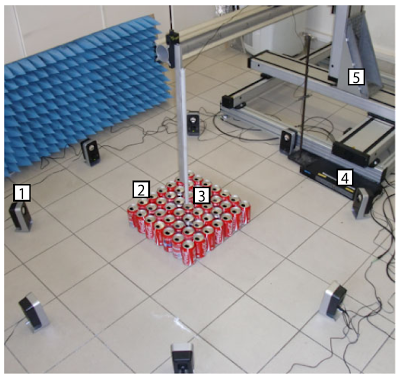By James Van Howe
 Setup of the metalens (soda cans) used to focus a sound wave to a size of 1/25 th of the wavelength of the waves used to generate the beam. From PRL, 107, 64301.
Setup of the metalens (soda cans) used to focus a sound wave to a size of 1/25 th of the wavelength of the waves used to generate the beam. From PRL, 107, 64301.
This post originally appeared on Jim’s CLEO Blog and is reproduced with permission from the author.
Professor Mathias Fink from ESPCI ParisTech and Institut Langevin doesn’t fit the typical profile for a plenary speaker at an optics conference, which is precisely why why you won’t want to miss his plenary talk at CLEO 2012 this May. Though acoustics is the consistent medium for his work, his research more broadly consists of understanding the nature of waves and how to get around the limits assumed by our conventional understanding, such as diffraction-limited focusing and imaging. Much of professor Fink’s work since the late 1990′s has been using time-reversal, the subject of his upcoming plenary talk, to achieve these ends.
For example, in the August 5, 2011 issue of Physical Review Letters, Fink and collaborators demonstrated that they could focus a sound wave to 1/25 th of the wavelength of the waves used to create the focused beam. Ironically, this novel feat was obtained using very conventional objects- soda cans and computer speakers.
The MacGyveresque experiment shown in the figure above uses a grid of soda cans, a group of subwavelength acoustic resonators, to act as a “metalens“. When illuminated with a broadband field, this metalens allows subwavelength detail in the near-field to be encoded onto propagating waves. Essentially the metalens is a very good evanescent-to-propagating-wave converter, “unsticking” evanescent waves with subwavelength detail that are typically locked to the surface of the object (or source) of interest. This phenomenon is analogous to the generation of surface plasmons in near-field microscopy (see the August 16th post below). The propagating waves, now containing subwavelength information, can be detected in the far-field and time-reversed (essentially run backwards) in order to focus to subwavelength spots….(for the full original post click here)
Posted: 22 October 2011 by
James Van Howe
| with 0 comments